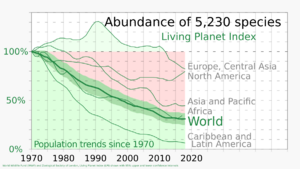Living Planet Index facts for kids
The Living Planet Index (LPI) is like a health check for Earth's wildlife. It shows how well different animal populations are doing around the world. This index focuses on vertebrate animals. These include mammals, birds, reptiles, amphibians, and fish.
The Zoological Society of London (ZSL) and the World Wide Fund for Nature (WWF) work together to manage this important index. As of 2022, the LPI uses information from over 31,000 groups of animals. These groups cover more than 5,200 different species.
Contents
What the Living Planet Index Shows
The 2022 report from the Living Planet Index shared some important findings. It showed that wildlife populations have dropped by about 69% on average. This decline happened between 1970 and 2018. This suggests that natural places are changing very quickly.
Where Wildlife Populations Are Declining
The decline in animal numbers is not the same everywhere. For example, in Latin America and the Caribbean, animal populations have dropped by an average of 94%. This is a very big change.
Why Wildlife Populations Are Declining
One of the main reasons for these declines is how humans use land. This often leads to habitat loss. Habitats are the natural homes of animals. When forests are cut down or land is used for farming, animals lose their homes.
How the Living Planet Index Is Calculated
The Living Planet Database (LPD) holds all the information used for the LPI. This database has been online since 2013. The ZSL has managed it since 2016. It contains over 30,000 records of animal population changes. These records cover more than 5,200 species.
Gathering Information for the LPI
The information for the LPI comes from many places. These include scientific journals, online databases, and government reports. Scientists use this data to see how animal populations have changed over time.
Putting the Numbers Together
To create the global LPI, scientists use special math methods. They look at how each animal population has changed. Then, they combine these changes to create an index for different systems. These systems are land, water, and oceans. Finally, they average these three indexes to get the global LPI.
Who Publishes the Living Planet Index
The WWF first developed the Living Planet Index in 1997. They worked with the World Conservation Monitoring Centre (UNEP-WCMC). The WWF published the first index report in 1998. Since 2006, the ZSL and WWF have worked together to manage it.
Where to Find the Results
The results of the LPI are shared every two years. They are published in the WWF Living Planet Report. You can also find them in other big reports. These include the Millennium Ecosystem Assessment. The latest Living Planet Report came out in October 2022.
Understanding the Living Planet Index
Sometimes, people misunderstand what the LPI shows. Some media reports incorrectly say that 69% of all animals have disappeared. This is not what the LPI means.
The LPI shows the average decline in monitored populations. It does not mean that 69% of all individual animals or species are gone. It tracks the trends in how many animals are in certain groups.
The Living Planet Index and Global Goals
The LPI plays an important role in global efforts to protect nature.
Convention on Biological Diversity
In 2002 and 2006, many countries met for the Convention on Biological Diversity (CBD). They promised to slow down the loss of biological diversity by 2010. The LPI helped measure if they were making progress.
The CBD also uses the LPI to track goals for 2011-2020. These are part of the Aichi Biodiversity Targets. Scientists at ZSL work to make sure the LPI is accurate. They also try to include more types of animals. This helps us better understand changes in biodiversity.
See also
 In Spanish: Índice Planeta Vivo para niños
In Spanish: Índice Planeta Vivo para niños


